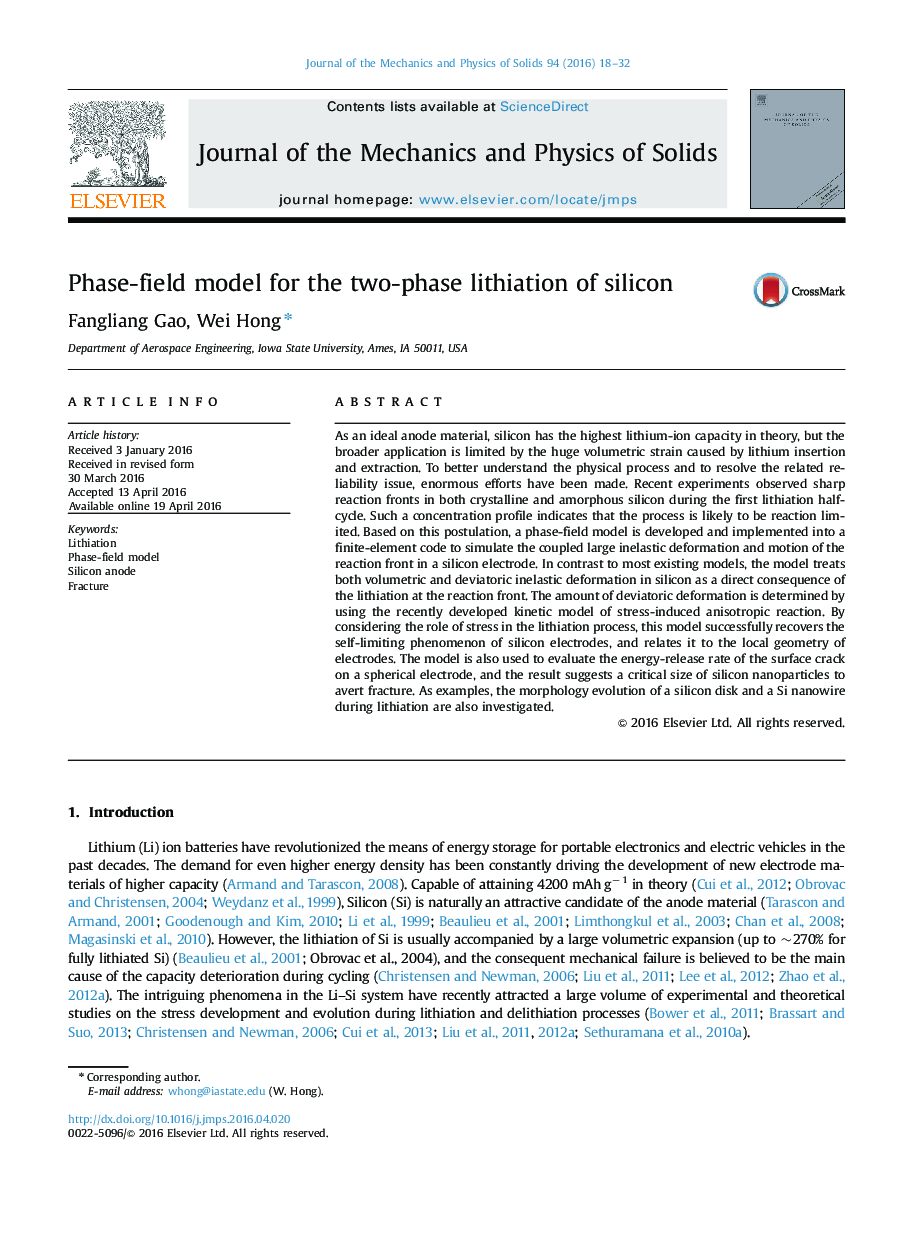| کد مقاله | کد نشریه | سال انتشار | مقاله انگلیسی | نسخه تمام متن |
|---|---|---|---|---|
| 7177671 | 1467049 | 2016 | 15 صفحه PDF | دانلود رایگان |
عنوان انگلیسی مقاله ISI
Phase-field model for the two-phase lithiation of silicon
ترجمه فارسی عنوان
مدل میدان مغناطیسی فازی برای لایتسیون دو فازی سیلیکون
دانلود مقاله + سفارش ترجمه
دانلود مقاله ISI انگلیسی
رایگان برای ایرانیان
کلمات کلیدی
لیتینگ، مدل میدان فاز، آندز سیلیکون، شکستگی،
ترجمه چکیده
به عنوان ماده ایده آل آند، سیلیکون دارای بالاترین ظرفیت لیتیوم یون در نظر گرفته شده است، اما کاربرد وسیع آن از طریق فشار حجمی بزرگ ناشی از ورود و استخراج لیتیوم محدود شده است. برای درک بهتر فرآیند فیزیکی و حل مسئله مربوط به قابلیت اطمینان، تلاش های بزرگی صورت گرفته است. در آزمایش های اخیر، واکنش های واکنش تیز در هر دو سیلیکون بلورین و آمورف در طول نیمه اول چرخه ی لیتیستینگ مشاهده شد. چنین مشخصات غلظت نشان دهنده این است که این فرآیند احتمالا واکنش محدود است. بر اساس این فرض، یک مدل میدان فاز توسعه داده شده و به یک کد عنصر محدودی برای شبیه سازی تغییر شکل ناپیانی بزرگ همراه و حرکت جبهه واکنش در یک الکترود سیلیکون توسعه داده شده و اجرا شده است. در مقایسه با اکثر مدل های موجود، این مدل هر دو تغییر شکل ناپذیری حجمی و انحرافی در سیلیکون را به عنوان یک نتیجه مستقیم از لایتسیون در قسمت واکنش می پردازد. مقدار تغییر شکل انحرافی با استفاده از مدل اخیر سینتیکی واکنش آنیزوتروپیک ناشی از استرس تعیین شده است. با در نظر گرفتن نقش استرس در فرایند لیتیزاسیون، این مدل موفقیت آمیز پدیده خود محدودیت الکترودهای سیلیکونی را بهبود می بخشد و آن را به هندسه محلی الکترودها مرتبط می سازد. این مدل همچنین برای ارزیابی میزان انتشار انرژی کراک سطحی بر روی یک الکترود کروی استفاده می شود و نتیجه نشان می دهد که اندازه کراتی نانو ذرات سیلیکون برای جلوگیری از شکستگی است. به عنوان مثال، تکامل مورفولوژی دیسک سیلیکون و یک نانوسیم سی در طول لایتسیون نیز بررسی شده است.
موضوعات مرتبط
مهندسی و علوم پایه
سایر رشته های مهندسی
مهندسی مکانیک
چکیده انگلیسی
As an ideal anode material, silicon has the highest lithium-ion capacity in theory, but the broader application is limited by the huge volumetric strain caused by lithium insertion and extraction. To better understand the physical process and to resolve the related reliability issue, enormous efforts have been made. Recent experiments observed sharp reaction fronts in both crystalline and amorphous silicon during the first lithiation half-cycle. Such a concentration profile indicates that the process is likely to be reaction limited. Based on this postulation, a phase-field model is developed and implemented into a finite-element code to simulate the coupled large inelastic deformation and motion of the reaction front in a silicon electrode. In contrast to most existing models, the model treats both volumetric and deviatoric inelastic deformation in silicon as a direct consequence of the lithiation at the reaction front. The amount of deviatoric deformation is determined by using the recently developed kinetic model of stress-induced anisotropic reaction. By considering the role of stress in the lithiation process, this model successfully recovers the self-limiting phenomenon of silicon electrodes, and relates it to the local geometry of electrodes. The model is also used to evaluate the energy-release rate of the surface crack on a spherical electrode, and the result suggests a critical size of silicon nanoparticles to avert fracture. As examples, the morphology evolution of a silicon disk and a Si nanowire during lithiation are also investigated.
ناشر
Database: Elsevier - ScienceDirect (ساینس دایرکت)
Journal: Journal of the Mechanics and Physics of Solids - Volume 94, September 2016, Pages 18-32
Journal: Journal of the Mechanics and Physics of Solids - Volume 94, September 2016, Pages 18-32
نویسندگان
Fangliang Gao, Wei Hong,
